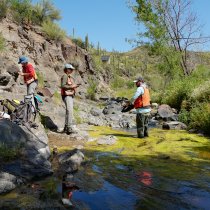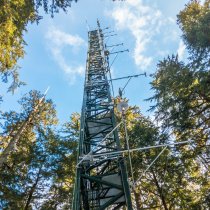Behind the push for NEON
July 28, 2011
Climate is changing rapidly and rates of climate change may well be more rapid than ecological systems can respond. This year’s 30-year climate normals (1981-2010) are 0.5o warmer than the 1971-2000 baseline. While climate, land cover and invasive species are changing rapidly, as Terry Root, Camille Parmesan and colleagues have shown, species ranges change at highly variable rates and significant changes to more mobile and/or vulnerable species are already evident. The National Ecological Observatory is a bold effort to begin characterizing bioclimate, species distributions and ecosystem function early enough in this era of rapid change to form a rigorous basis for ecological forecasting in a time of complex and unprecedented change.
In a dynamic climate, species distributions may be matched to their environment (e.g. for highly mobile species), or they may be in disequilibrium (for long-lived or dispersal-limited species). Modern ecology began late in the Holocene period, a 12,000-year long period of relatively stable climate conditions during the latter part of which global mean temperatures varied by only a degree or so. While this time period was not long enough for complete biotic adjustment to temperature (As Margaret David has shown, some northern tree species were still migrating north as the Anthropocene began), it did allow for the development of relative stability of biotic communities. Evidence from atmospheric CO2 and its isotopes, sensitive indicators of large-scale biotic change, support the idea that despite emerging human activity, the biosphere and its large-scale carbon balance were relatively quiescent. As a result, ecologists and conservation biologists often assume that species traits will remain in equilibrium with climate and other factors, leading to widespread use of techniques such as gradient analysis and climate envelope techniques with climate and other environmental factors, concepts that date back to at least Whittaker.
But as climate – and the environmental factors that NEON will measure – change (land use, air quality, effects of invasions on species distributions), not only does information from quasi-stable correlations between climate and species distributions vanish, but forecasting becomes intrinsically more difficult. Steve Carpenter and colleagues have shown that as systems move further from steady state, complex dynamics become more and more likely, and non-climatic factors such as dispersal, competition and human impacts (land use, invasives) may dominate before climate effects once again stabilize. In addition to physiological changes driving community dynamics, climate effects on disturbance regimes (for example wildfire or the North American Mountain Pine Beetle) may drive ecosystems into states not readily predictable from our current limited data. All of this points to the need for ecological forecasting in support of future management of ecosystems and ecosystem services. Further, the situation creates an imperative for sustaining and enhancing the current efforts to characterize global biodiversity and functional diversity by any means feasible.
NEON, coordinating studies of drivers of change, species-level biology and integrated ecosystem function, will play a key role in building this knowledge. There are many reasons for this, but a major one is to understand the environmental sensitivity of the globe’s current living systems. NEON data will provide a foundation for predictive modeling to identify the vulnerability of the current biosphere, and as a foundation for adaptation in the future. As the climate changes, concurrent with changes to land use, widespread biological invasions and disturbance regimes, data collected on species distributions in the future will contain less and less information about species traits and their relationship to the environment. The urgency of obtaining global data on biodiversity and functional diversity, and obtaining coordinated and continental-scale observations while stable late Holocene distributions still exist, remains an imperative even in these challenging times for science, the nation, and the world.

